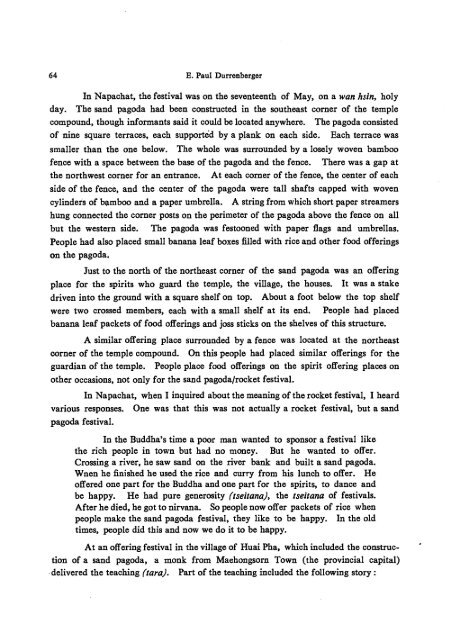The Journal of the Siam Society Vol. LXXI, Part 1-2, 1983 - Khamkoo
The Journal of the Siam Society Vol. LXXI, Part 1-2, 1983 - Khamkoo
The Journal of the Siam Society Vol. LXXI, Part 1-2, 1983 - Khamkoo
Create successful ePaper yourself
Turn your PDF publications into a flip-book with our unique Google optimized e-Paper software.
64 B. Paul Durrenberger<br />
In Napachat, <strong>the</strong> festival was on <strong>the</strong> seventeenth <strong>of</strong> May, on a wan hsin, holy<br />
day. <strong>The</strong> sand pagoda had been constructed in <strong>the</strong> sou<strong>the</strong>ast corner <strong>of</strong> <strong>the</strong> temple<br />
compound, though informants said it could be located anywhere. <strong>The</strong> pagoda consisted<br />
<strong>of</strong> nine square terraces, each supported by a plank on each side. Each terrace was<br />
smaller than <strong>the</strong> one below. <strong>The</strong> whole was surrounded by a losely woven bamboo<br />
fence with a space between <strong>the</strong> base <strong>of</strong> <strong>the</strong> pagoda and <strong>the</strong> fence. <strong>The</strong>re was a gap at<br />
<strong>the</strong> northwest corner for an entrance. At each comer <strong>of</strong> <strong>the</strong> fence, <strong>the</strong> center <strong>of</strong> each<br />
side <strong>of</strong> <strong>the</strong> fence, and <strong>the</strong> center <strong>of</strong> <strong>the</strong> pagoda were tall shafts capped with woven<br />
cylinders <strong>of</strong> b~mboo and a paper umbrella. A string from which short paper streamers<br />
hung connected <strong>the</strong> corner posts on <strong>the</strong> perimeter <strong>of</strong> <strong>the</strong> pagoda ~bove <strong>the</strong> fence on all<br />
but <strong>the</strong> western side. <strong>The</strong> pagoda was festooned with paper :flags and umbrellas.<br />
People had also placed small banana leaf boxes filled with rice and o<strong>the</strong>r food <strong>of</strong>ferings<br />
on <strong>the</strong> pagoda.<br />
Just to <strong>the</strong> north <strong>of</strong> <strong>the</strong> nor<strong>the</strong>ast corner <strong>of</strong> <strong>the</strong> sand pagoda was an <strong>of</strong>fering<br />
place for <strong>the</strong> spirits who guard <strong>the</strong> temple, <strong>the</strong> village, <strong>the</strong> houses. It was a stake<br />
driven into <strong>the</strong> ground with a square shelf on top. About a foot below <strong>the</strong> top shelf<br />
were two crossed members, each with a small shelf at its end. People had placed<br />
banana leaf packets <strong>of</strong> food <strong>of</strong>ferings and joss sticks on <strong>the</strong> shelves <strong>of</strong> this structure.<br />
A similar <strong>of</strong>fering place surrounded by a fence was located at <strong>the</strong> nor<strong>the</strong>ast<br />
corner <strong>of</strong> <strong>the</strong> temple compound. On this people had placed similar <strong>of</strong>ferings for <strong>the</strong><br />
guardian <strong>of</strong> <strong>the</strong> temple. People place food <strong>of</strong>ferings on <strong>the</strong> spirit <strong>of</strong>fering places on<br />
o<strong>the</strong>r occasions, not only for <strong>the</strong> sand pagoda/rocket festival.<br />
In Napachat, when I inquired about <strong>the</strong> meaning <strong>of</strong> <strong>the</strong> rocket festival, I heard<br />
various responses. One was that this was not actually a rocket festival, but a sand<br />
pagoda festival.<br />
In <strong>the</strong> Buddha's time a poor man wanted to sponsor a festival like<br />
<strong>the</strong> rich people in town but had no money. But he wanted to <strong>of</strong>fer.<br />
Crossing a river, he saw sand on <strong>the</strong> river bank ~d built a sand pagoda.<br />
Wnen he finished he used <strong>the</strong> rice and curry from his lunch to <strong>of</strong>fer. He<br />
<strong>of</strong>fered one part for <strong>the</strong> Buddha and one part for <strong>the</strong> spirits, to dance and<br />
be happy. He had pure generosity (tseitana), <strong>the</strong> tseitana <strong>of</strong> festivals.<br />
After he died, he got to nirvana. So people now <strong>of</strong>fer packets <strong>of</strong> rice when<br />
people make <strong>the</strong> sand pagoda festival, <strong>the</strong>y like to be happy. In <strong>the</strong> old<br />
times, people did this and now we do it to be happy.<br />
At an <strong>of</strong>fering festival in <strong>the</strong> village <strong>of</strong> Huai Pha, which included <strong>the</strong> construction<br />
<strong>of</strong> a sand pagoda, a monk from Maehongsom Town (<strong>the</strong> provincial capital)<br />
·delivered <strong>the</strong> teaching (tara). <strong>Part</strong> <strong>of</strong> <strong>the</strong> teaching included <strong>the</strong> following story:

















